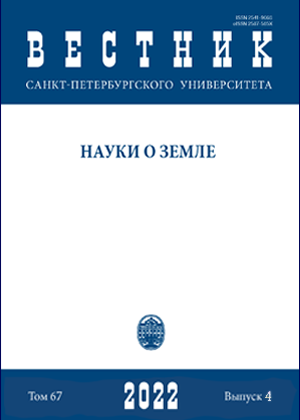Petrological model for formation of felsic volcanic rocks of the Pecherkinskaya Formation (northwestern part of the Salair Ridge)
DOI:
https://doi.org/10.21638/spbu07.2022.403Abstract
The geochemical and isotopic (Nd, Sr) characteristics of felsic volcanic rocks of the Pecherkinskaya Formation in the northwestern part of the Salair Ridge were studied. These rocks are closely associated with industrially significant deposits and manifestations of gold- and silver-bearing pyrite-polymetallic formations with potentially gold-bearing weathering crusts on them. The study of the material composition of unaltered volcanic rocks of the Pecherkinskaya Formation is necessary for the reconstruction of the conditions of their formation, which contributes to estimation of the mineragenic potential of this formation and the conditions during the accumulation of ore matter. Felsic volcanic rocks of the Pecherkinskaya Formation are an extreme member of the basalt-plagioryolite series, have an extremely high-sodium type of alkalinity with a low potassium content, are calcareous and characterized by high silica contents, low iron content, have low REE concentrations, are enriched in Pb and U and depleted in Ta and Nb, are characterized by high values of εNd (t) (+6.36) and primary ratio 87Sr / 86Sr (0.706977). The REE distribution spectra show a low degree of fractionation with a pronounced negative "europium anomaly". The geochemical composition of the Pecherkinskaya Formation volcanic rocks indicates that primary magmas were formed by partial melting of rocks of the lower continental crust at a pressure of ~ 8 kbar in equilibrium with Hbl + Cpx + Pl ± Opx restite and a temperature of ~ 750-790 ° C. The isotope-geochemical characteristics indicating the participation of depleted mantle in the source are probably inherited from the juvenile crust, the rocks of which could have been formed as a result of differentiation of mantle magmas. Geological and geochemical features of felsic volcanic rocks of the Pecherkinskaya Formation are characteristic of igneous rocks formed under conditions of oceanic arcs.
Keywords:
geochemistry, petrogenesis, felsic volcanism, Cambrian, Salair, Pecherkinskaya Formation, geodynamic model
Downloads
References
Бабин, Г. А., Владимиров, А. Г., Руднев, С. Н. (2003). Венд-кембрийские вулканические пояса Алтае-Саянской складчатой области. Современные проблемы формационного анализа, петрология и рудоносность магматических образований: матер. Всерос. совещ. Новосибирск: Изд-во СО РАН, 24-26.
Бабин, Г. А., Шокальский, С. П. (2017). Основные черты геологического строения Алтае-Саянской складчатой области (тектоническое районирование, стратиграфия, магматизм, история геологического развития). Геология и минерально-сырьевые ресурсы Сибири, S, 19-37.
Ветрова, Н. И., Ветров, Е. В., Летникова, Е. Ф., Солошенко, Н. Г. (2022). Возраст кинтерепской свиты Северо-Западного Салаира: данные хемостратиграфии и U-Pb датирования циркона. Геодинамика и тектонофизика, 13 (2). https://doi.org/10.5800/GT-2022-13-2s-0597
Государственная геологическая карта Российской Федерации (2015). Масштаб 1:1 000 000 (третье поколение). Серия Алтае-Саянская. Лист N-44; Новосибирск. Объяснительная записка. СПб.: ВСЕГЕИ.
Зоненшайн, Л. П., Кузьмин, М. И., Натапов, Л. М. (1990). Тектоника литосферных плит территории СССР. М.: Недра.
Легенда Алтае-Саянской серии листов Государственной геологической карты Российской Федерации масштаба 1:1 000 000 / Бабин, Г. А., Зейферт, Л. Л., Щигрев, А. Ф. и др. (2006). 3-е изд. Новокузнецк.
Condie, K. C. (2001). Mantle plumes and their record in Earth history. Oxford: Cambridge University Press. https://doi.org/10.1017/CBO9780511810589
De Paolo, D. J., Linn, A. M. and Schubert, G. (1991). The continental crust age distribution: methods of determining mantle separation ages from Sm-Nd isotopic data and application to the southwestern United States. J. Geophys. Res., 96, B 2, 2071-2088.
Faure, G. (1986). Principles of Isotope Geology. New York: John Wiley and Sons.
Frost, B. R., Barnes, C. G., Collins, W. J., Arculus, R. J., Ellis, D. J. and Frost, C. D. (2001). A geochemical classification for granitic rocks. J. Petrol., 42, 2033-2048. https://doi.org/10.1093/petrology/42.11.2033
Harris, N. B. W., Pearse, J. A. and Tindle, A. G. (1986). Geochemical characteristics of collision-zone magmatism. In: M. P. Cowards, A. C. Ries, eds. Collisions tectonics. Geological Society (London, Special Publ.), 19, 67-81. https://doi.org/10.1144/GSL.SP.1986.019.01.04
Large, R. R., Gemmell, J. B., Paulick, H. and Huston, D. L. (2001). The alteration box plot: a simple approach to understanding the relationship between alteration mineralogy and lithogeochemistry associated with volcanic-hosted massive sulfide deposits. Econ. Geol., 96 (5), 957-971. https://doi.org/10.2113/gsecongeo.96.5.957
Liew, T. C. and Hofmann, A. W. (1988). Precambrian crustal components, plutonic associations, plate environment of the Hercynian Fold Belt of Central Europe: Indications from a Nd and Sr isotopic study. Contrib. Mineral. Petrol., 98, 129-138.
Pearce, J. A., Harris, N. B. W. and Tindle A. G. (1984). Trace element discrimination diagrams for the tectonic interpretation of granitic rocks. J. Petrol., 25, 956-983. https://doi.org/10.1093/petrology/25.4.956
Rudnick, R. L. and Gao, S. (2003). 3-01 - Composition of the Continental Crust. In: H. D. Holland, K. K. Turekian, eds. Treatise on Geochemistry, vol. 3, 1-64. Oxford, Elsevier-Pergamon. https://doi.org/10.1016/B0-08-043751-6/03016-4
Sun, S.-s. and McDonough, W. F. (1989). Chemical and isotopic systematics of oceanic basalts: implications for mantle composition and processes. Geological Society (London, Special Publ.), 42, 313-345. https://doi.org/10.1144/GSL.SP.1989.042.01.19
Taylor, S. R. and McLennan, S. M. (1985). The continental crust: Its composition and evolution: An examination of the geochemical record preserved in sedimentary rocks. Oxford, Blackwell Scientific Publ.
Turkina, O. M. (2000) Model geochemical types of tonalite-trondhjemite melts and their natural equivalents. Geochemistry Int., 7, 704-717.
Watkins, J. M., Clemens, J. D. and Treloar, P. J. (2007). Archaean TTGs as sources of younger granitic magmas: melting of sodic metatonalites at 0.6-1.2 GPa. Contrib. Mineral. Petrol., 154, 91-110. https://doi.org/10.1007/s00410-007-0181-0
Watson, E. B. and Harrison, T. M. (1983). Zircon saturation revisited: temperature and composition effects in a variety of crustal magma types. Earth Planet. Sci. Lett., 64, 295-304. https://doi.org/10.1016/0012-821X(83)90211-X
Wedepohl, K.-H. (1995). The composition of the continental crust. Geochimica et Cosmochimica Acta., 59, 1217-1232. https://doi.org/10.1016/0016-7037(95)00038-2
Wilson, M. (1989). Igneous Petrogenesis: A Global Tectonic Approach. London, Unwyn Hyman. https://doi.org/10.1007/978-1-4020-6788-4
Winchester, J. A. and Floyd, P. A. (1977). Geochemical Discrimination of Different Magma Series and Their Differentiation Product Using Immobile Elements. Chemical Geology, 20, 325-343. http://dx.doi.org/10.1016/0009-2541(77)90057-2
Downloads
Published
How to Cite
Issue
Section
License
Articles of "Vestnik of Saint Petersburg University. Earth Sciences" are open access distributed under the terms of the License Agreement with Saint Petersburg State University, which permits to the authors unrestricted distribution and self-archiving free of charge.






